A Breugel painting. A winter landscape in aerial perspective. Villagers skating or playing on ice. In the foreground a trapdoor set to catch birds. A scene believed to symbolize the precariousness of life. But which Breugel painted it amongst this formidable dynasty of Flemish painters? Pieter ‘Peasant’ Breugel the Elder its founding genius? His sons Pieter or Jan Breughel the Younger? Or was it one of the many talented offspring who kept the Breughel reputation alive for four generations?
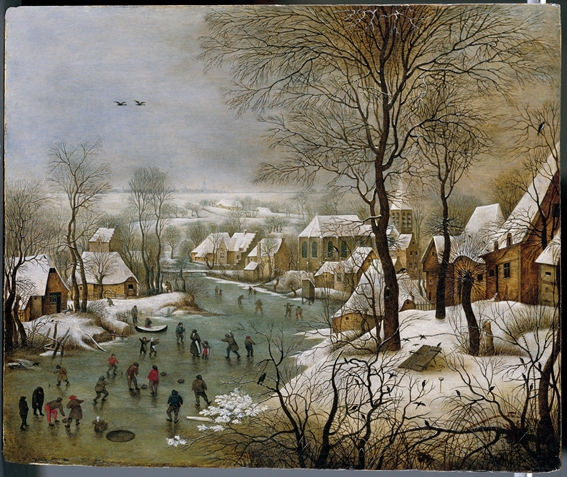
Many questions like this one are resolved in All My Sons, a unique show newly opened at the Tel Aviv Museum. Alive with color, excitement and movement, it features one hundred paintings, drawings and engravings by the most distinguished members of this family, illustrating the special qualities of each.
Only a small number of works by Pieter Breugel the Elder (1520-69) survive today. . Priceless items in the collections of major museums, it is no surprise that none are included in this exhibition. Nevertheless, many of this master’s most famous paintings (like the Birdtrap illustrated above) are to be found here, albeit through copies or versions produced by his descendants. So, in truth, as one moves through the galleries, the presence of Pieter Bruegel the Elder is strongly felt, starting in the first room where works by artists who influenced his development are displayed.
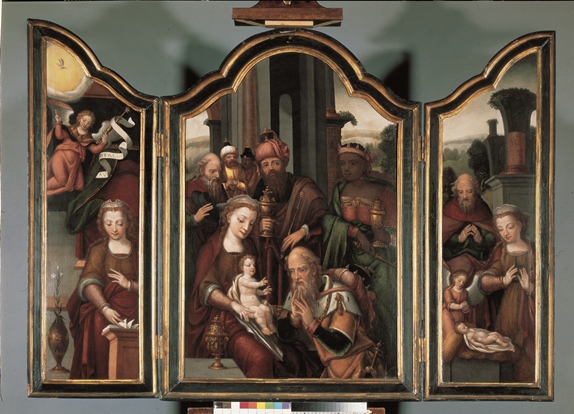
During his lifetime, comparisons were made between Pieter Bruegel the Elder’s imagery and early style of painting and those of Hieronymus Bosch, the Dutch painter known best for his fantasy renderings of Hell. In fact, in some quarters, Bruegel was heralded as the new Bosch. But how could he have seen his work, since Bosch died in 1516, four years before Breugel was born? Clearly, he would only have had access to copies of Bosch’s paintings which were on sale, perhaps, in the marketplace. Highlighting the link between these two artists is a Bosch’s masterwork: The Seven Deadly Sins (1500-1515), on loan from the Arts Foundation, Geneva.
Hung alongside is The Adoration of the Magi, a devotional triptych by Antwerp artist Pieter Coecke van Aelst and his workshop. (Bruegel, the Elder, was apprenticed to van Aelst and would marry his daughter.) It is fascinating to compare this serene piece whose figures and composition illustrate the growing influence of the Italian Renaissance on Flemish painting with the boisterous detailed scenes of peasant and village life that came from the brush of Pieter Bruegel the Elder.
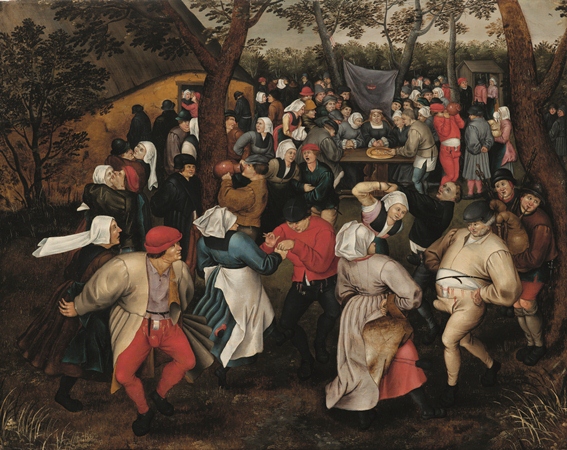
Pieter Breughel the Younger (1564-1638) – (the ‘h’ was added to distinguish him from his father,) one of Breugel the Elder’s two sons, is well represented in this show. This is fitting, since he was the most faithful amongst all his father’s descendants in pursuing his father’s images and themes, even though he lacked his brilliant touch.
His Outdoor Wedding Dance – a brightly colored village scene of peasants dancing, drinking and making merry – is based on his father’s painting Wedding Dance in the Open Air (1566), now in the collection of the Institute of Arts, Detroit. This is not a direct copy, Breughel the Younger has re-arranged the scene and painted in new figures. Nevertheless, some of the imagery is taken from other famous paintings by Pieter Breugel the Elder. For instance, the plump, disagreeable-looking bride that he has painted sitting at a table is transposed directly from The Peasant Wedding Feast (1567) now in the Kunsthistorisches Museum, Vienna.
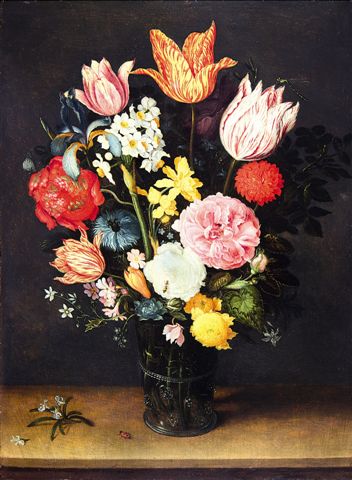
Jan Brueghel the Elder (1568-1625), the second son, specialized in flower and landscape painting. He was nicknamed ‘Velvet’ Breughel; perhaps due to the velvety sheen he gave his paintings. There are many captivating examples of his work on show, among them a painting of tulips and roses in a glass vase. This was a collaborative effort between him and Jan Brueghel the Younger (1601-1678), painted at a time when his son would have been in his late teens and apprenticed to his father. Since this painting depicts both flowers in full bloom as well as a few fallen sprigs, it may be viewed as a Vanitas picture carrying a message regarding the transience of all living things. I prefer to see it as the artists’ way of exulting the beauty of Nature.
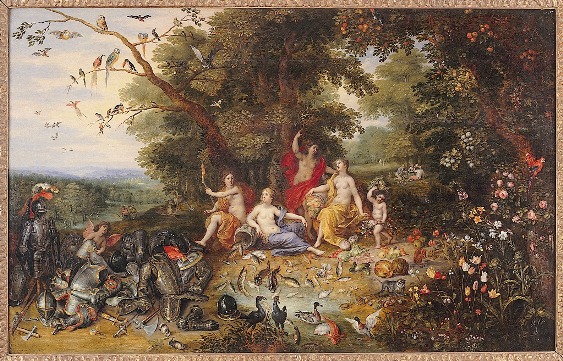
Collaboration between painters of different artistic streams was quite usual in 17th century Flanders. Jan Brueghel the Younger collaborated with artists representing the dramatic (Baroque) stream in Netherlandish painting such as Peter Paul Rubens and Hendrick van Balen. Some of these collaborative paintings were allegories – scenes with a hidden meaning, usually a moral or political one. One attractive example is The Allegory of the Four Elements painted by van Balen together with Jan Brueghel the Younger, each contributing his specialist skills. Van Balen painted the four goddesses representing Fire, Water, Air and Earth or Fertility, while Brueghel masterfully depicted the suits of armor, flowers, birds, fish and exotic birds.
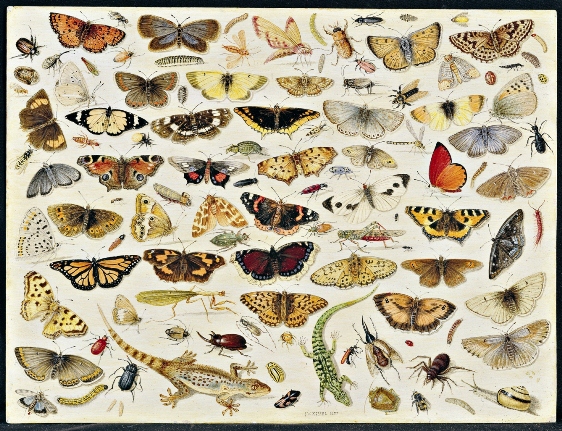
Jan Breughel the Younger had eleven children, among them five sons who became painters. He also had a sister (granddaughter of Pieter Breugel the Elder) whose son Jan van Kessel 1 (1626-1679) was a brilliant painter of flowers, insects and birds. Apparently Kessel consulted illustrated scientific texts to obtain the greatest accuracy possible, as some stunning examples of his work reveal.
The Brueghel story does not stop here. Paintings by other descendants and relatives of Pieter Breugel the elder are also included in this exhibition. Look out especially for paintings by David Teniers the Younger (1610-1690) located in the far gallery. Married to Anna, granddaughter of the eldest Bruegel, Teniers became one Europe’s most important painters. He is represented, among other works, by two wonderfully lifelike scenes. One showing peasants harvesting apples (in the collection of Tel Aviv Museum), and another depicting peasants huddled together in a tavern, drinking and smoking their pipes.
This fine exhibition was co-curated by senior Tel Aviv Museum curator Doron J. Lurie and Sergio Gaddi, Cultural Councillor of the city of Como, Italy, where this exhibition will open at the Villa Olmo in March of next year.
Tel Aviv Museum of Art, main building, 27 Shaul Hamelech Blvd, Till Nov. 30th 2012.






A very well written review that stimulates the reader to see the exhibition as soon as possible.
Comments are closed.